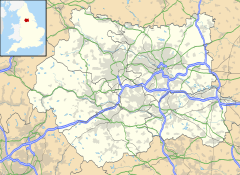Netherton, Wakefield facts for kids
Quick facts for kids Netherton |
|
|---|---|
 Netherton |
|
| OS grid reference | SE2716 |
| Metropolitan borough | |
| Metropolitan county | |
| Region | |
| Country | England |
| Sovereign state | United Kingdom |
| Post town | Wakefield |
| Postcode district | WF4 |
| Dialling code | 01924 |
| Police | West Yorkshire |
| Fire | West Yorkshire |
| Ambulance | Yorkshire |
| EU Parliament | Yorkshire and the Humber |
| UK Parliament |
|
Netherton is a village found in the City of Wakefield area of West Yorkshire, England. It is located about 4 miles (6.4 km) southwest of Wakefield city. The village is also 3 miles (4.8 km) south of Ossett and 1 mile (1.6 km) south of Horbury.
Netherton is part of the Wakefield Rural ward, which is managed by the Wakefield Metropolitan District Council. The name of the village can be seen on an old map from 1646 called "Dvcatvs Eboracensis pars occidentalis".
Long ago, the name of a nearby place was "Shitlington". The letter 'h' was later removed. In 1929, the name Sitlington was officially adopted. This change was approved by the local government at the time, the West Riding County Council.
Contents
A Look at Netherton's History
Netherton was once known as Nether Shitlington. It was part of a larger area called Shitlington. This area also included Over Shitlington (Overton) and Middle Shitlington (Middlestown). These places were all part of an old church area called Thornhill.
In 1963, a very old axe from the Mesolithic period (Middle Stone Age) was found near the Star Inn. This suggests that people lived in the Shitlington area a very long time ago. The area was likely settled during Anglo-Saxon times. It was even mentioned in the famous Domesday Book as Schellingtone. The Domesday Book was a huge survey of England ordered by William the Conqueror in 1085.
Netherton Hall is a large, old house. It was built around 1775 for the Perkins family. Today, it is a Grade II* listed building, which means it is very important historically. St Andrew's Church was built in 1881. It was designed by an architect named J. D. Sedding.
Coal Mining in Netherton
Coal mining was a very important industry in Netherton's past. A special railway line was built to carry coal from Caphouse Colliery, a coal mine owned by Sir John Lister Lister-Kaye. This line connected to the main Lancashire and Yorkshire Railway and to coal loading points on the Calder and Hebble Navigation, a canal at Calder Grove. The railway line passed right through Netherton.
It went past a small group of houses called Little London on South Lane. Here, the mining company owned a pit called Victoria Pit. Another mine, the Prince of Wales Pit, was dug near New Hall Wood in 1870. People in the area called it Wood Pit. Its main shaft was made deeper and wider in 1882. A second shaft was dug 12 years later.
Later, in 1926 and again 30 years later, special tunnels called drifts were dug. When the coal mines became owned by the government in 1947, the Prince of Wales Pit was renamed Denby Grange (Prince of Wales). It joined with Caphouse Colliery in 1981. However, this mine closed down in August 1991. Today, a timber business called Earnshaws uses the site. This company has been operating since 1860.
Another important coal mine was Hartley Bank Colliery. It was dug in 1872 on the south side of the Calder and Hebble Navigation canal. This mine closed in 1968. Sadly, in May 1924, there was a terrible accident. A dangerous gas called firedamp caught fire. This accident caused the deaths of five miners and injured 26 other men.
Netherton's Location and Land
Netherton village is located on the B6117 road. This road goes from Horbury Bridge to Midgley. The village sits on a hill. From this hill, you can look down into the valley of the River Calder.
The ground beneath Netherton is made up of rock layers that contain coal. This area is part of the South Yorkshire Coalfield. This means that for a long time, there was a lot of coal available for mining in the region.
Famous Faces from Netherton
The members of the indie rock band The Cribs are originally from Netherton. They grew up in the village before becoming famous musicians.


